LSBM306: A Case Study on Strategy, Enterprise, and Innovation at Grab
VerifiedAdded on 2023/06/15
|9
|3088
|113
Case Study
AI Summary
This case study delves into the strategy, enterprise, and innovation of Grab, a leading mobile technology and transportation company in Southeast Asia. It explores key drivers of innovation, applying frameworks such as Schumpeter's Innovation Theory of Profit, Porter's generic strategies (Cost Leadership, Differentiation, Cost Focus, and Differentiation Focus), the Ansoff Matrix (Market Penetration, Product Development, Market Development, and Diversification), and Blue Ocean Strategy. The analysis highlights how Grab has leveraged technology, competition, and sustainability to drive innovation and achieve competitive advantage. The report concludes with recommendations based on the strategic frameworks discussed, emphasizing the importance of continuous innovation for sustained growth and market leadership. Desklib provides access to similar case studies and assignments for students.
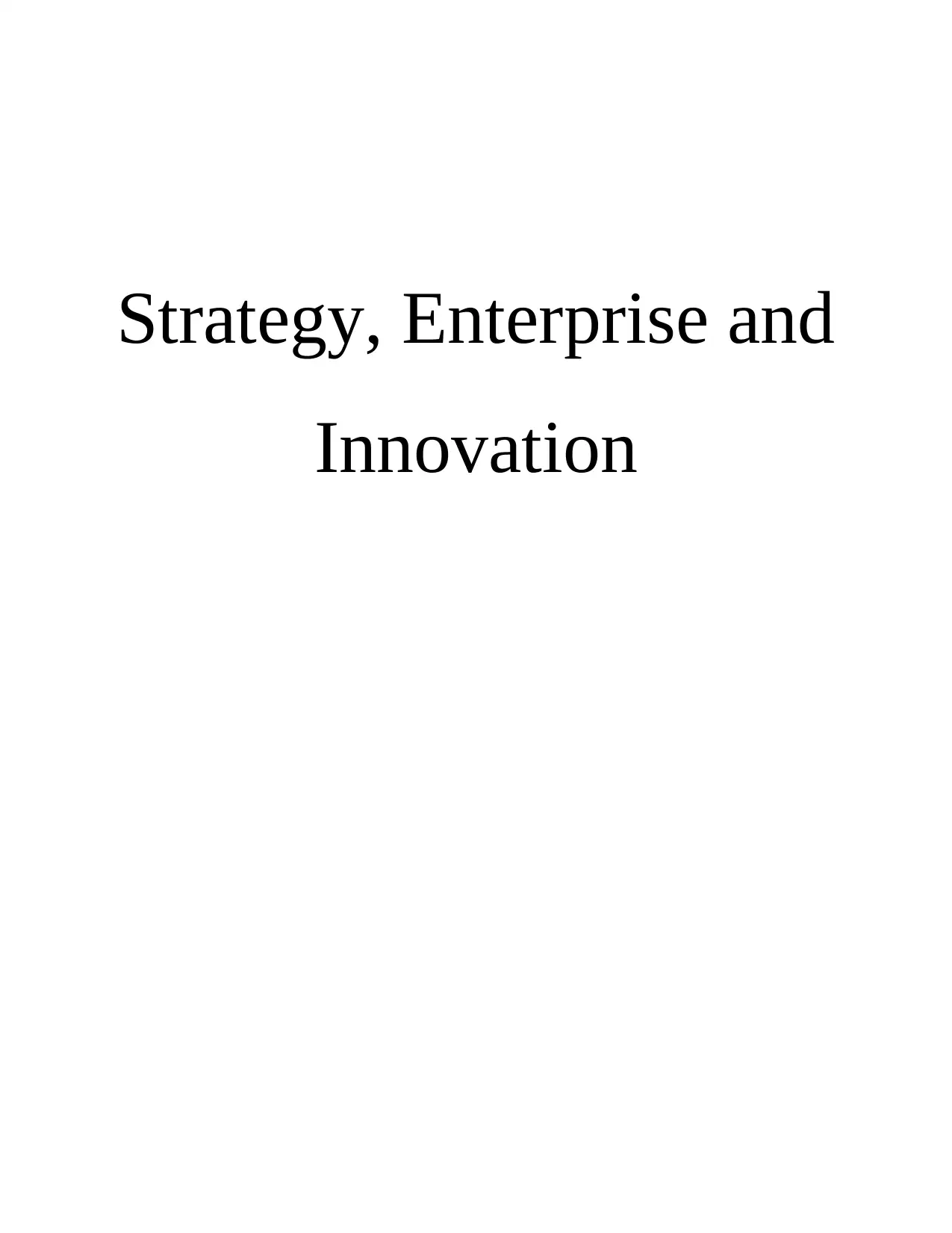
Strategy, Enterprise and
Innovation
Innovation
Paraphrase This Document
Need a fresh take? Get an instant paraphrase of this document with our AI Paraphraser
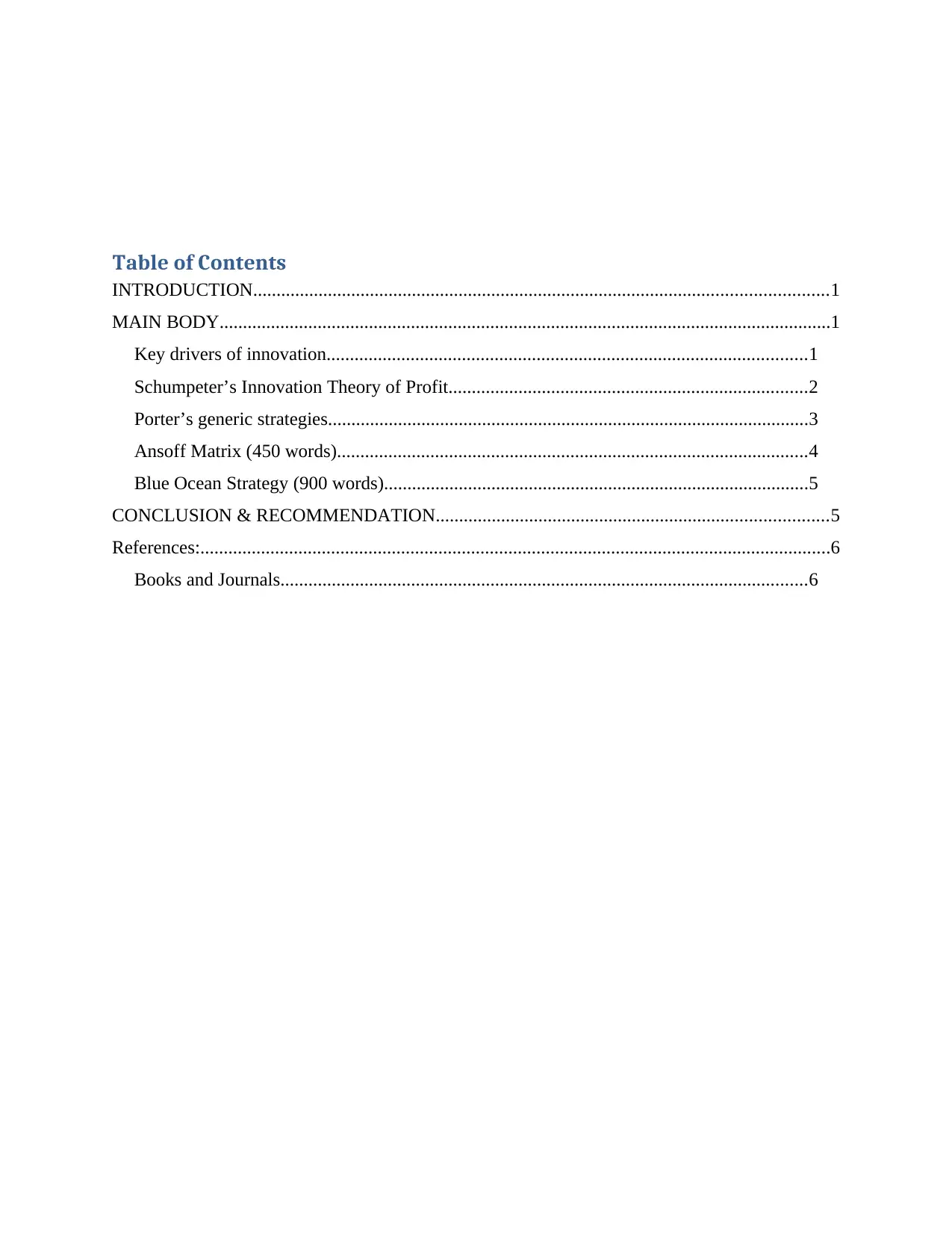
Table of Contents
INTRODUCTION...........................................................................................................................1
MAIN BODY...................................................................................................................................1
Key drivers of innovation.......................................................................................................1
Schumpeter’s Innovation Theory of Profit.............................................................................2
Porter’s generic strategies.......................................................................................................3
Ansoff Matrix (450 words).....................................................................................................4
Blue Ocean Strategy (900 words)...........................................................................................5
CONCLUSION & RECOMMENDATION....................................................................................5
References:.......................................................................................................................................6
Books and Journals.................................................................................................................6
INTRODUCTION...........................................................................................................................1
MAIN BODY...................................................................................................................................1
Key drivers of innovation.......................................................................................................1
Schumpeter’s Innovation Theory of Profit.............................................................................2
Porter’s generic strategies.......................................................................................................3
Ansoff Matrix (450 words).....................................................................................................4
Blue Ocean Strategy (900 words)...........................................................................................5
CONCLUSION & RECOMMENDATION....................................................................................5
References:.......................................................................................................................................6
Books and Journals.................................................................................................................6
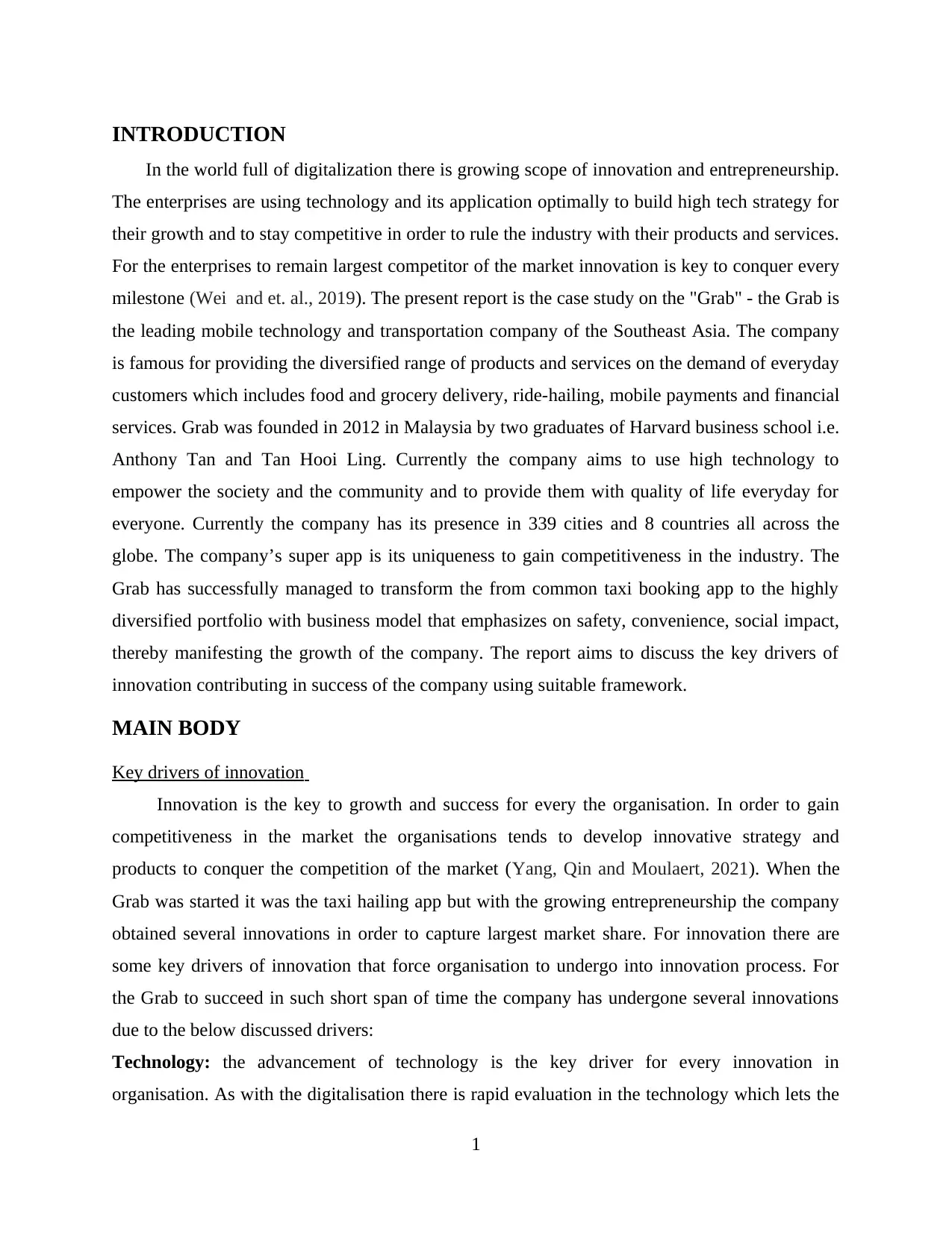
INTRODUCTION
In the world full of digitalization there is growing scope of innovation and entrepreneurship.
The enterprises are using technology and its application optimally to build high tech strategy for
their growth and to stay competitive in order to rule the industry with their products and services.
For the enterprises to remain largest competitor of the market innovation is key to conquer every
milestone (Wei and et. al., 2019). The present report is the case study on the "Grab" - the Grab is
the leading mobile technology and transportation company of the Southeast Asia. The company
is famous for providing the diversified range of products and services on the demand of everyday
customers which includes food and grocery delivery, ride-hailing, mobile payments and financial
services. Grab was founded in 2012 in Malaysia by two graduates of Harvard business school i.e.
Anthony Tan and Tan Hooi Ling. Currently the company aims to use high technology to
empower the society and the community and to provide them with quality of life everyday for
everyone. Currently the company has its presence in 339 cities and 8 countries all across the
globe. The company’s super app is its uniqueness to gain competitiveness in the industry. The
Grab has successfully managed to transform the from common taxi booking app to the highly
diversified portfolio with business model that emphasizes on safety, convenience, social impact,
thereby manifesting the growth of the company. The report aims to discuss the key drivers of
innovation contributing in success of the company using suitable framework.
MAIN BODY
Key drivers of innovation
Innovation is the key to growth and success for every the organisation. In order to gain
competitiveness in the market the organisations tends to develop innovative strategy and
products to conquer the competition of the market (Yang, Qin and Moulaert, 2021). When the
Grab was started it was the taxi hailing app but with the growing entrepreneurship the company
obtained several innovations in order to capture largest market share. For innovation there are
some key drivers of innovation that force organisation to undergo into innovation process. For
the Grab to succeed in such short span of time the company has undergone several innovations
due to the below discussed drivers:
Technology: the advancement of technology is the key driver for every innovation in
organisation. As with the digitalisation there is rapid evaluation in the technology which lets the
1
In the world full of digitalization there is growing scope of innovation and entrepreneurship.
The enterprises are using technology and its application optimally to build high tech strategy for
their growth and to stay competitive in order to rule the industry with their products and services.
For the enterprises to remain largest competitor of the market innovation is key to conquer every
milestone (Wei and et. al., 2019). The present report is the case study on the "Grab" - the Grab is
the leading mobile technology and transportation company of the Southeast Asia. The company
is famous for providing the diversified range of products and services on the demand of everyday
customers which includes food and grocery delivery, ride-hailing, mobile payments and financial
services. Grab was founded in 2012 in Malaysia by two graduates of Harvard business school i.e.
Anthony Tan and Tan Hooi Ling. Currently the company aims to use high technology to
empower the society and the community and to provide them with quality of life everyday for
everyone. Currently the company has its presence in 339 cities and 8 countries all across the
globe. The company’s super app is its uniqueness to gain competitiveness in the industry. The
Grab has successfully managed to transform the from common taxi booking app to the highly
diversified portfolio with business model that emphasizes on safety, convenience, social impact,
thereby manifesting the growth of the company. The report aims to discuss the key drivers of
innovation contributing in success of the company using suitable framework.
MAIN BODY
Key drivers of innovation
Innovation is the key to growth and success for every the organisation. In order to gain
competitiveness in the market the organisations tends to develop innovative strategy and
products to conquer the competition of the market (Yang, Qin and Moulaert, 2021). When the
Grab was started it was the taxi hailing app but with the growing entrepreneurship the company
obtained several innovations in order to capture largest market share. For innovation there are
some key drivers of innovation that force organisation to undergo into innovation process. For
the Grab to succeed in such short span of time the company has undergone several innovations
due to the below discussed drivers:
Technology: the advancement of technology is the key driver for every innovation in
organisation. As with the digitalisation there is rapid evaluation in the technology which lets the
1
⊘ This is a preview!⊘
Do you want full access?
Subscribe today to unlock all pages.

Trusted by 1+ million students worldwide
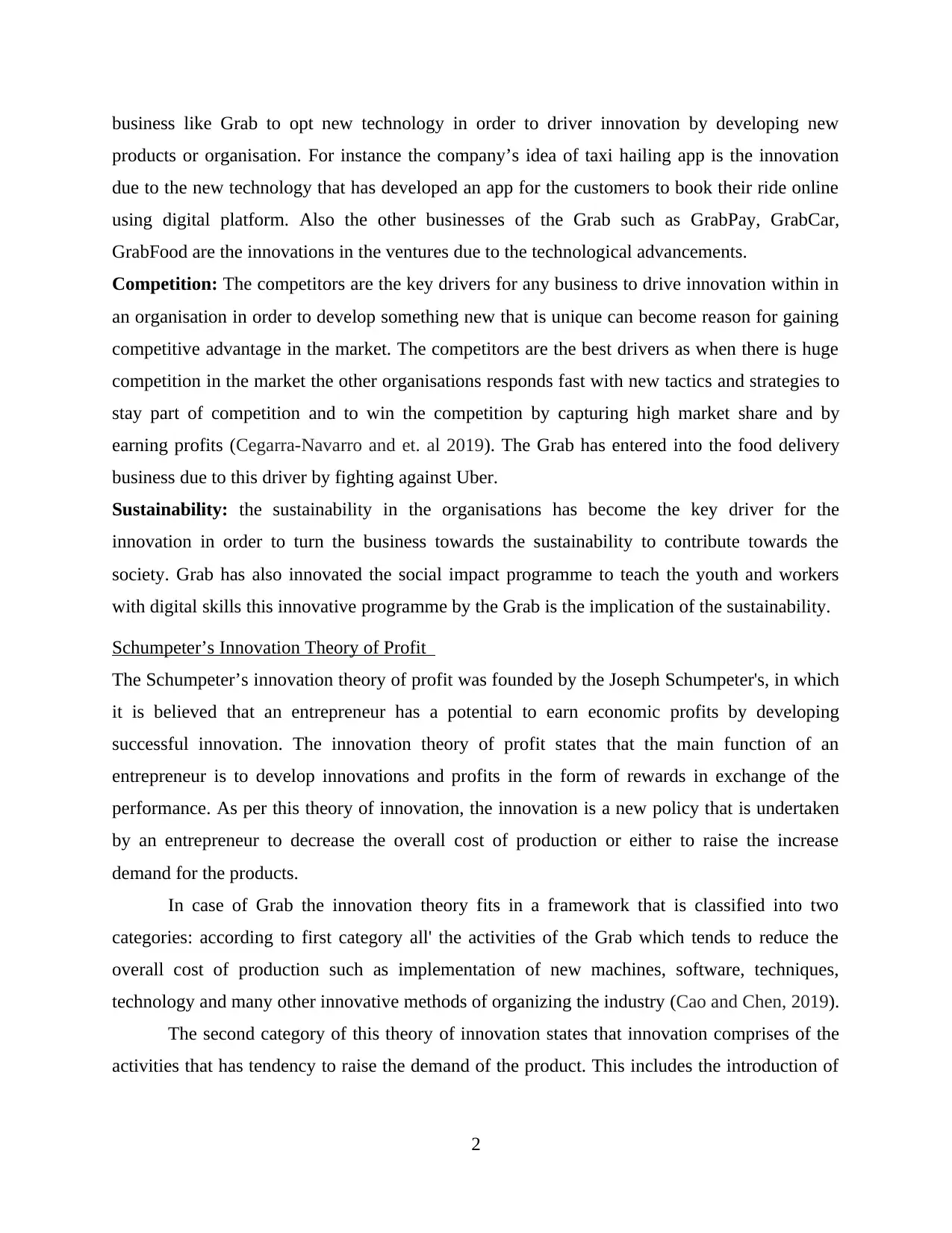
business like Grab to opt new technology in order to driver innovation by developing new
products or organisation. For instance the company’s idea of taxi hailing app is the innovation
due to the new technology that has developed an app for the customers to book their ride online
using digital platform. Also the other businesses of the Grab such as GrabPay, GrabCar,
GrabFood are the innovations in the ventures due to the technological advancements.
Competition: The competitors are the key drivers for any business to drive innovation within in
an organisation in order to develop something new that is unique can become reason for gaining
competitive advantage in the market. The competitors are the best drivers as when there is huge
competition in the market the other organisations responds fast with new tactics and strategies to
stay part of competition and to win the competition by capturing high market share and by
earning profits (Cegarra-Navarro and et. al 2019). The Grab has entered into the food delivery
business due to this driver by fighting against Uber.
Sustainability: the sustainability in the organisations has become the key driver for the
innovation in order to turn the business towards the sustainability to contribute towards the
society. Grab has also innovated the social impact programme to teach the youth and workers
with digital skills this innovative programme by the Grab is the implication of the sustainability.
Schumpeter’s Innovation Theory of Profit
The Schumpeter’s innovation theory of profit was founded by the Joseph Schumpeter's, in which
it is believed that an entrepreneur has a potential to earn economic profits by developing
successful innovation. The innovation theory of profit states that the main function of an
entrepreneur is to develop innovations and profits in the form of rewards in exchange of the
performance. As per this theory of innovation, the innovation is a new policy that is undertaken
by an entrepreneur to decrease the overall cost of production or either to raise the increase
demand for the products.
In case of Grab the innovation theory fits in a framework that is classified into two
categories: according to first category all' the activities of the Grab which tends to reduce the
overall cost of production such as implementation of new machines, software, techniques,
technology and many other innovative methods of organizing the industry (Cao and Chen, 2019).
The second category of this theory of innovation states that innovation comprises of the
activities that has tendency to raise the demand of the product. This includes the introduction of
2
products or organisation. For instance the company’s idea of taxi hailing app is the innovation
due to the new technology that has developed an app for the customers to book their ride online
using digital platform. Also the other businesses of the Grab such as GrabPay, GrabCar,
GrabFood are the innovations in the ventures due to the technological advancements.
Competition: The competitors are the key drivers for any business to drive innovation within in
an organisation in order to develop something new that is unique can become reason for gaining
competitive advantage in the market. The competitors are the best drivers as when there is huge
competition in the market the other organisations responds fast with new tactics and strategies to
stay part of competition and to win the competition by capturing high market share and by
earning profits (Cegarra-Navarro and et. al 2019). The Grab has entered into the food delivery
business due to this driver by fighting against Uber.
Sustainability: the sustainability in the organisations has become the key driver for the
innovation in order to turn the business towards the sustainability to contribute towards the
society. Grab has also innovated the social impact programme to teach the youth and workers
with digital skills this innovative programme by the Grab is the implication of the sustainability.
Schumpeter’s Innovation Theory of Profit
The Schumpeter’s innovation theory of profit was founded by the Joseph Schumpeter's, in which
it is believed that an entrepreneur has a potential to earn economic profits by developing
successful innovation. The innovation theory of profit states that the main function of an
entrepreneur is to develop innovations and profits in the form of rewards in exchange of the
performance. As per this theory of innovation, the innovation is a new policy that is undertaken
by an entrepreneur to decrease the overall cost of production or either to raise the increase
demand for the products.
In case of Grab the innovation theory fits in a framework that is classified into two
categories: according to first category all' the activities of the Grab which tends to reduce the
overall cost of production such as implementation of new machines, software, techniques,
technology and many other innovative methods of organizing the industry (Cao and Chen, 2019).
The second category of this theory of innovation states that innovation comprises of the
activities that has tendency to raise the demand of the product. This includes the introduction of
2
Paraphrase This Document
Need a fresh take? Get an instant paraphrase of this document with our AI Paraphraser
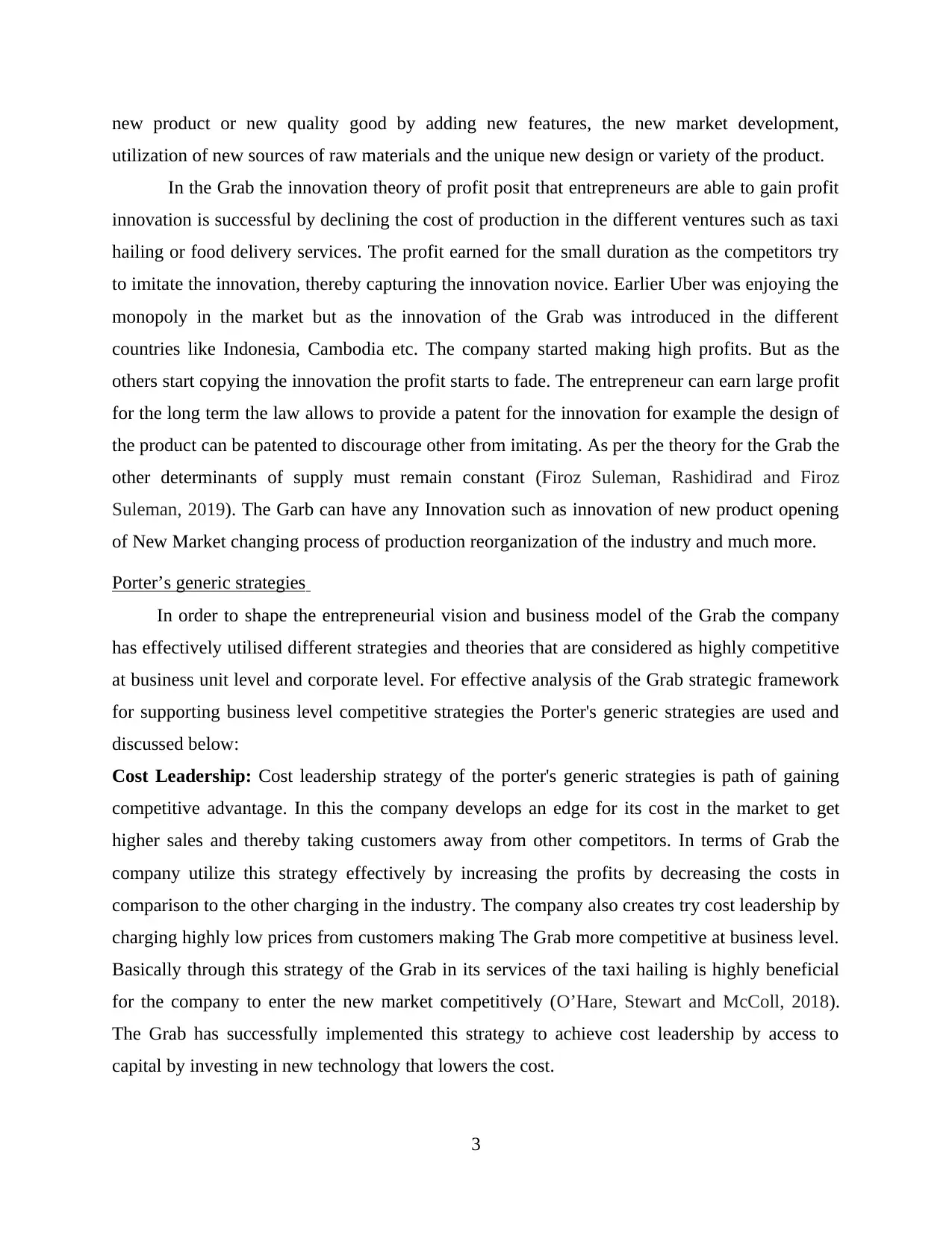
new product or new quality good by adding new features, the new market development,
utilization of new sources of raw materials and the unique new design or variety of the product.
In the Grab the innovation theory of profit posit that entrepreneurs are able to gain profit
innovation is successful by declining the cost of production in the different ventures such as taxi
hailing or food delivery services. The profit earned for the small duration as the competitors try
to imitate the innovation, thereby capturing the innovation novice. Earlier Uber was enjoying the
monopoly in the market but as the innovation of the Grab was introduced in the different
countries like Indonesia, Cambodia etc. The company started making high profits. But as the
others start copying the innovation the profit starts to fade. The entrepreneur can earn large profit
for the long term the law allows to provide a patent for the innovation for example the design of
the product can be patented to discourage other from imitating. As per the theory for the Grab the
other determinants of supply must remain constant (Firoz Suleman, Rashidirad and Firoz
Suleman, 2019). The Garb can have any Innovation such as innovation of new product opening
of New Market changing process of production reorganization of the industry and much more.
Porter’s generic strategies
In order to shape the entrepreneurial vision and business model of the Grab the company
has effectively utilised different strategies and theories that are considered as highly competitive
at business unit level and corporate level. For effective analysis of the Grab strategic framework
for supporting business level competitive strategies the Porter's generic strategies are used and
discussed below:
Cost Leadership: Cost leadership strategy of the porter's generic strategies is path of gaining
competitive advantage. In this the company develops an edge for its cost in the market to get
higher sales and thereby taking customers away from other competitors. In terms of Grab the
company utilize this strategy effectively by increasing the profits by decreasing the costs in
comparison to the other charging in the industry. The company also creates try cost leadership by
charging highly low prices from customers making The Grab more competitive at business level.
Basically through this strategy of the Grab in its services of the taxi hailing is highly beneficial
for the company to enter the new market competitively (O’Hare, Stewart and McColl, 2018).
The Grab has successfully implemented this strategy to achieve cost leadership by access to
capital by investing in new technology that lowers the cost.
3
utilization of new sources of raw materials and the unique new design or variety of the product.
In the Grab the innovation theory of profit posit that entrepreneurs are able to gain profit
innovation is successful by declining the cost of production in the different ventures such as taxi
hailing or food delivery services. The profit earned for the small duration as the competitors try
to imitate the innovation, thereby capturing the innovation novice. Earlier Uber was enjoying the
monopoly in the market but as the innovation of the Grab was introduced in the different
countries like Indonesia, Cambodia etc. The company started making high profits. But as the
others start copying the innovation the profit starts to fade. The entrepreneur can earn large profit
for the long term the law allows to provide a patent for the innovation for example the design of
the product can be patented to discourage other from imitating. As per the theory for the Grab the
other determinants of supply must remain constant (Firoz Suleman, Rashidirad and Firoz
Suleman, 2019). The Garb can have any Innovation such as innovation of new product opening
of New Market changing process of production reorganization of the industry and much more.
Porter’s generic strategies
In order to shape the entrepreneurial vision and business model of the Grab the company
has effectively utilised different strategies and theories that are considered as highly competitive
at business unit level and corporate level. For effective analysis of the Grab strategic framework
for supporting business level competitive strategies the Porter's generic strategies are used and
discussed below:
Cost Leadership: Cost leadership strategy of the porter's generic strategies is path of gaining
competitive advantage. In this the company develops an edge for its cost in the market to get
higher sales and thereby taking customers away from other competitors. In terms of Grab the
company utilize this strategy effectively by increasing the profits by decreasing the costs in
comparison to the other charging in the industry. The company also creates try cost leadership by
charging highly low prices from customers making The Grab more competitive at business level.
Basically through this strategy of the Grab in its services of the taxi hailing is highly beneficial
for the company to enter the new market competitively (O’Hare, Stewart and McColl, 2018).
The Grab has successfully implemented this strategy to achieve cost leadership by access to
capital by investing in new technology that lowers the cost.
3
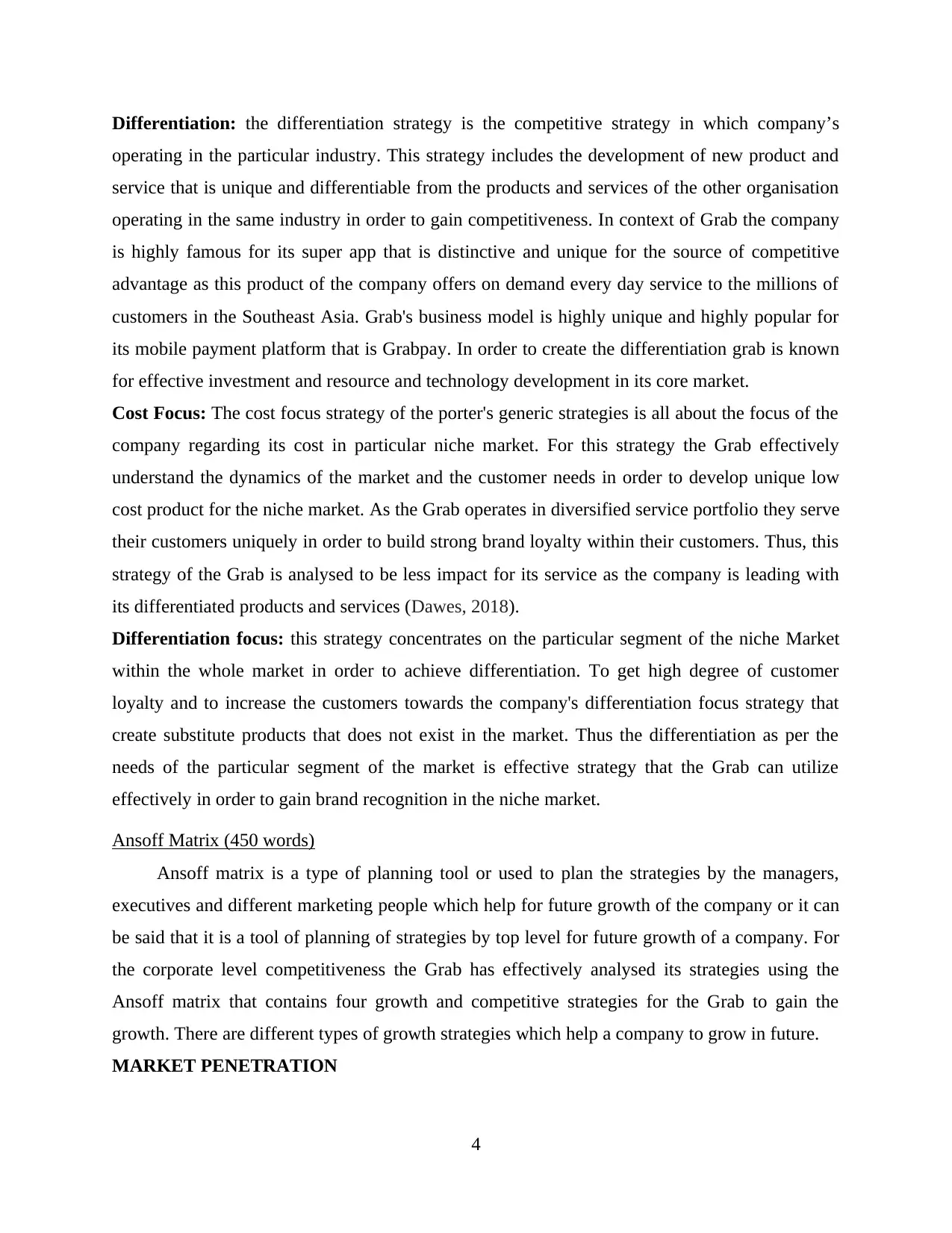
Differentiation: the differentiation strategy is the competitive strategy in which company’s
operating in the particular industry. This strategy includes the development of new product and
service that is unique and differentiable from the products and services of the other organisation
operating in the same industry in order to gain competitiveness. In context of Grab the company
is highly famous for its super app that is distinctive and unique for the source of competitive
advantage as this product of the company offers on demand every day service to the millions of
customers in the Southeast Asia. Grab's business model is highly unique and highly popular for
its mobile payment platform that is Grabpay. In order to create the differentiation grab is known
for effective investment and resource and technology development in its core market.
Cost Focus: The cost focus strategy of the porter's generic strategies is all about the focus of the
company regarding its cost in particular niche market. For this strategy the Grab effectively
understand the dynamics of the market and the customer needs in order to develop unique low
cost product for the niche market. As the Grab operates in diversified service portfolio they serve
their customers uniquely in order to build strong brand loyalty within their customers. Thus, this
strategy of the Grab is analysed to be less impact for its service as the company is leading with
its differentiated products and services (Dawes, 2018).
Differentiation focus: this strategy concentrates on the particular segment of the niche Market
within the whole market in order to achieve differentiation. To get high degree of customer
loyalty and to increase the customers towards the company's differentiation focus strategy that
create substitute products that does not exist in the market. Thus the differentiation as per the
needs of the particular segment of the market is effective strategy that the Grab can utilize
effectively in order to gain brand recognition in the niche market.
Ansoff Matrix (450 words)
Ansoff matrix is a type of planning tool or used to plan the strategies by the managers,
executives and different marketing people which help for future growth of the company or it can
be said that it is a tool of planning of strategies by top level for future growth of a company. For
the corporate level competitiveness the Grab has effectively analysed its strategies using the
Ansoff matrix that contains four growth and competitive strategies for the Grab to gain the
growth. There are different types of growth strategies which help a company to grow in future.
MARKET PENETRATION
4
operating in the particular industry. This strategy includes the development of new product and
service that is unique and differentiable from the products and services of the other organisation
operating in the same industry in order to gain competitiveness. In context of Grab the company
is highly famous for its super app that is distinctive and unique for the source of competitive
advantage as this product of the company offers on demand every day service to the millions of
customers in the Southeast Asia. Grab's business model is highly unique and highly popular for
its mobile payment platform that is Grabpay. In order to create the differentiation grab is known
for effective investment and resource and technology development in its core market.
Cost Focus: The cost focus strategy of the porter's generic strategies is all about the focus of the
company regarding its cost in particular niche market. For this strategy the Grab effectively
understand the dynamics of the market and the customer needs in order to develop unique low
cost product for the niche market. As the Grab operates in diversified service portfolio they serve
their customers uniquely in order to build strong brand loyalty within their customers. Thus, this
strategy of the Grab is analysed to be less impact for its service as the company is leading with
its differentiated products and services (Dawes, 2018).
Differentiation focus: this strategy concentrates on the particular segment of the niche Market
within the whole market in order to achieve differentiation. To get high degree of customer
loyalty and to increase the customers towards the company's differentiation focus strategy that
create substitute products that does not exist in the market. Thus the differentiation as per the
needs of the particular segment of the market is effective strategy that the Grab can utilize
effectively in order to gain brand recognition in the niche market.
Ansoff Matrix (450 words)
Ansoff matrix is a type of planning tool or used to plan the strategies by the managers,
executives and different marketing people which help for future growth of the company or it can
be said that it is a tool of planning of strategies by top level for future growth of a company. For
the corporate level competitiveness the Grab has effectively analysed its strategies using the
Ansoff matrix that contains four growth and competitive strategies for the Grab to gain the
growth. There are different types of growth strategies which help a company to grow in future.
MARKET PENETRATION
4
⊘ This is a preview!⊘
Do you want full access?
Subscribe today to unlock all pages.

Trusted by 1+ million students worldwide
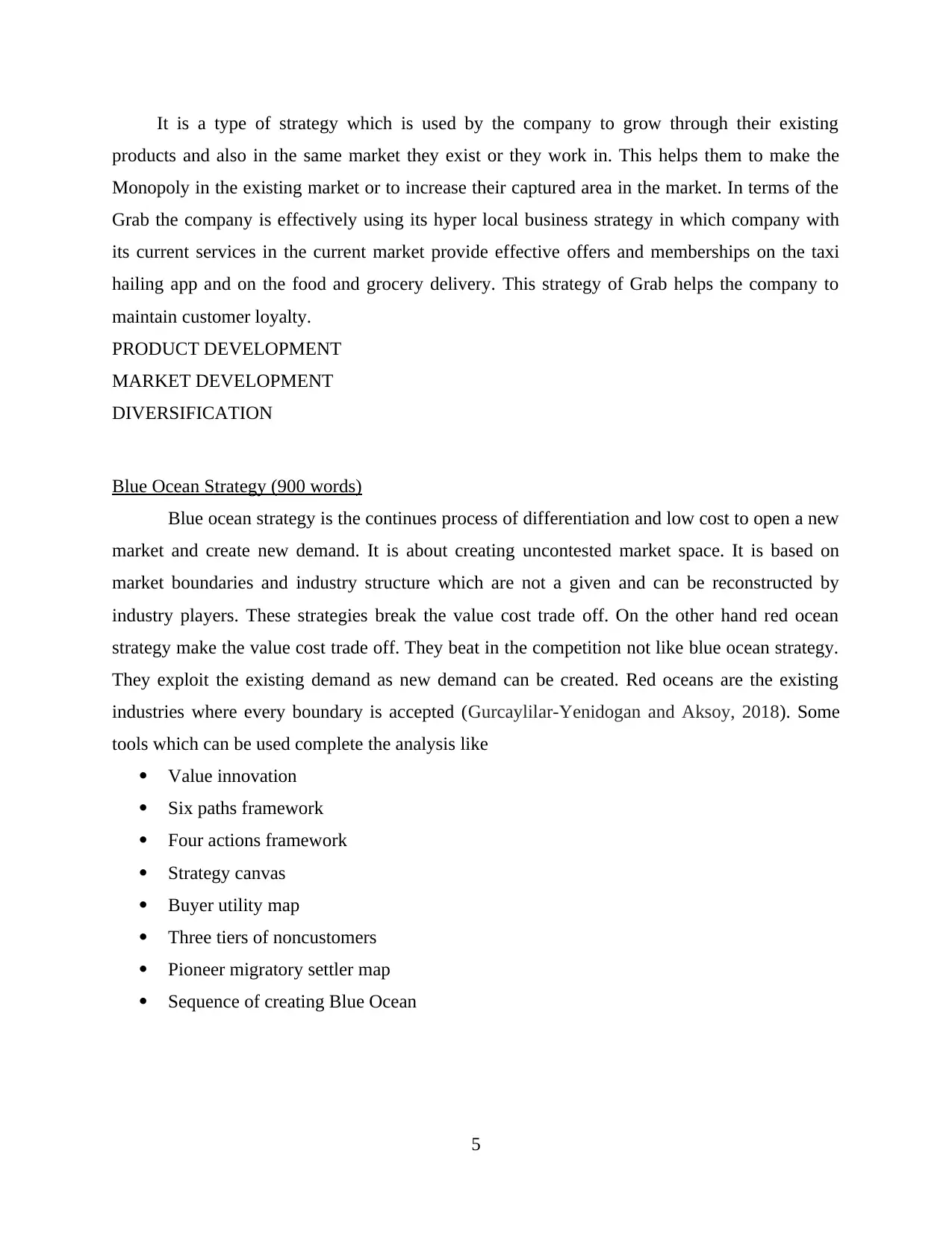
It is a type of strategy which is used by the company to grow through their existing
products and also in the same market they exist or they work in. This helps them to make the
Monopoly in the existing market or to increase their captured area in the market. In terms of the
Grab the company is effectively using its hyper local business strategy in which company with
its current services in the current market provide effective offers and memberships on the taxi
hailing app and on the food and grocery delivery. This strategy of Grab helps the company to
maintain customer loyalty.
PRODUCT DEVELOPMENT
MARKET DEVELOPMENT
DIVERSIFICATION
Blue Ocean Strategy (900 words)
Blue ocean strategy is the continues process of differentiation and low cost to open a new
market and create new demand. It is about creating uncontested market space. It is based on
market boundaries and industry structure which are not a given and can be reconstructed by
industry players. These strategies break the value cost trade off. On the other hand red ocean
strategy make the value cost trade off. They beat in the competition not like blue ocean strategy.
They exploit the existing demand as new demand can be created. Red oceans are the existing
industries where every boundary is accepted (Gurcaylilar-Yenidogan and Aksoy, 2018). Some
tools which can be used complete the analysis like
Value innovation
Six paths framework
Four actions framework
Strategy canvas
Buyer utility map
Three tiers of noncustomers
Pioneer migratory settler map
Sequence of creating Blue Ocean
5
products and also in the same market they exist or they work in. This helps them to make the
Monopoly in the existing market or to increase their captured area in the market. In terms of the
Grab the company is effectively using its hyper local business strategy in which company with
its current services in the current market provide effective offers and memberships on the taxi
hailing app and on the food and grocery delivery. This strategy of Grab helps the company to
maintain customer loyalty.
PRODUCT DEVELOPMENT
MARKET DEVELOPMENT
DIVERSIFICATION
Blue Ocean Strategy (900 words)
Blue ocean strategy is the continues process of differentiation and low cost to open a new
market and create new demand. It is about creating uncontested market space. It is based on
market boundaries and industry structure which are not a given and can be reconstructed by
industry players. These strategies break the value cost trade off. On the other hand red ocean
strategy make the value cost trade off. They beat in the competition not like blue ocean strategy.
They exploit the existing demand as new demand can be created. Red oceans are the existing
industries where every boundary is accepted (Gurcaylilar-Yenidogan and Aksoy, 2018). Some
tools which can be used complete the analysis like
Value innovation
Six paths framework
Four actions framework
Strategy canvas
Buyer utility map
Three tiers of noncustomers
Pioneer migratory settler map
Sequence of creating Blue Ocean
5
Paraphrase This Document
Need a fresh take? Get an instant paraphrase of this document with our AI Paraphraser
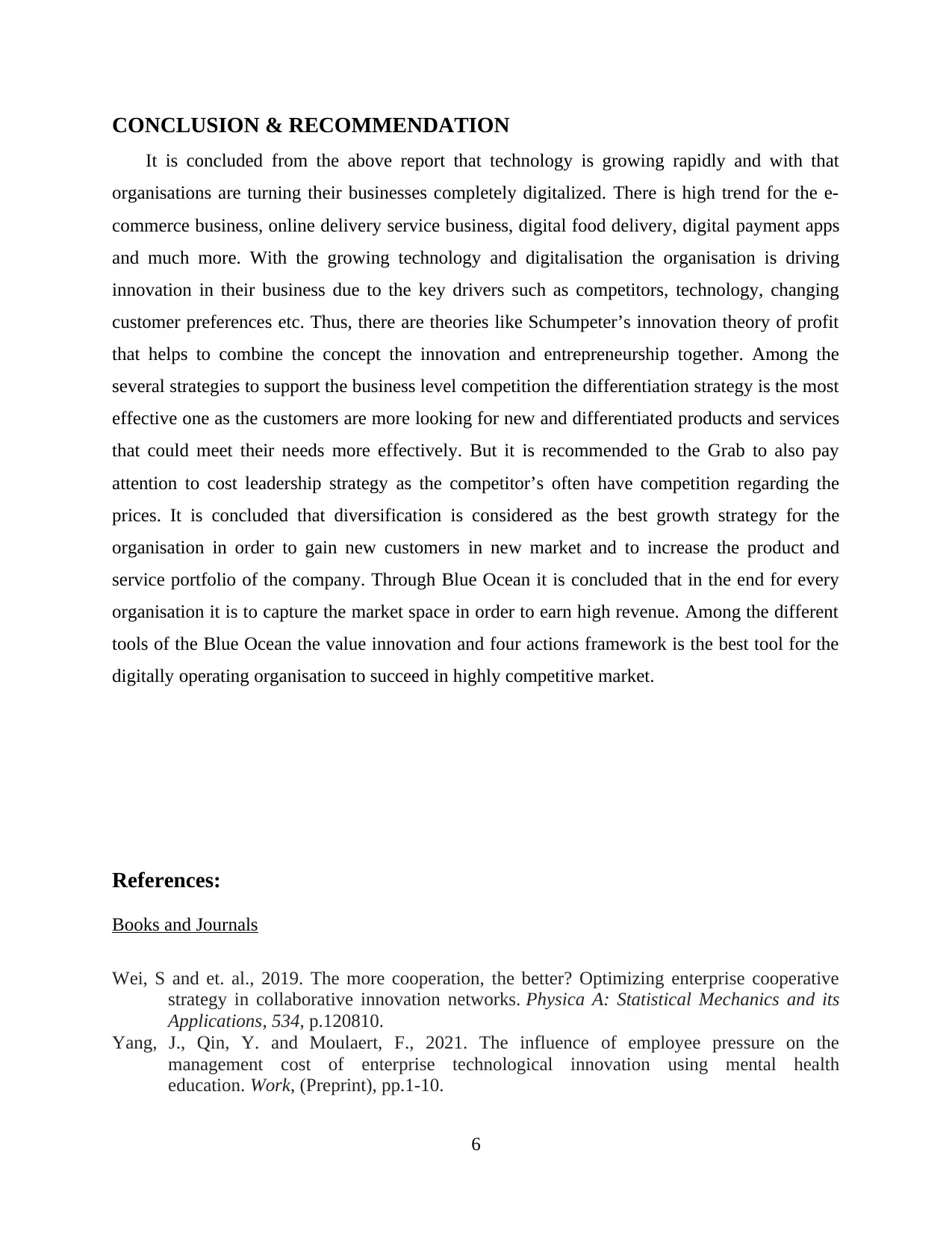
CONCLUSION & RECOMMENDATION
It is concluded from the above report that technology is growing rapidly and with that
organisations are turning their businesses completely digitalized. There is high trend for the e-
commerce business, online delivery service business, digital food delivery, digital payment apps
and much more. With the growing technology and digitalisation the organisation is driving
innovation in their business due to the key drivers such as competitors, technology, changing
customer preferences etc. Thus, there are theories like Schumpeter’s innovation theory of profit
that helps to combine the concept the innovation and entrepreneurship together. Among the
several strategies to support the business level competition the differentiation strategy is the most
effective one as the customers are more looking for new and differentiated products and services
that could meet their needs more effectively. But it is recommended to the Grab to also pay
attention to cost leadership strategy as the competitor’s often have competition regarding the
prices. It is concluded that diversification is considered as the best growth strategy for the
organisation in order to gain new customers in new market and to increase the product and
service portfolio of the company. Through Blue Ocean it is concluded that in the end for every
organisation it is to capture the market space in order to earn high revenue. Among the different
tools of the Blue Ocean the value innovation and four actions framework is the best tool for the
digitally operating organisation to succeed in highly competitive market.
References:
Books and Journals
Wei, S and et. al., 2019. The more cooperation, the better? Optimizing enterprise cooperative
strategy in collaborative innovation networks. Physica A: Statistical Mechanics and its
Applications, 534, p.120810.
Yang, J., Qin, Y. and Moulaert, F., 2021. The influence of employee pressure on the
management cost of enterprise technological innovation using mental health
education. Work, (Preprint), pp.1-10.
6
It is concluded from the above report that technology is growing rapidly and with that
organisations are turning their businesses completely digitalized. There is high trend for the e-
commerce business, online delivery service business, digital food delivery, digital payment apps
and much more. With the growing technology and digitalisation the organisation is driving
innovation in their business due to the key drivers such as competitors, technology, changing
customer preferences etc. Thus, there are theories like Schumpeter’s innovation theory of profit
that helps to combine the concept the innovation and entrepreneurship together. Among the
several strategies to support the business level competition the differentiation strategy is the most
effective one as the customers are more looking for new and differentiated products and services
that could meet their needs more effectively. But it is recommended to the Grab to also pay
attention to cost leadership strategy as the competitor’s often have competition regarding the
prices. It is concluded that diversification is considered as the best growth strategy for the
organisation in order to gain new customers in new market and to increase the product and
service portfolio of the company. Through Blue Ocean it is concluded that in the end for every
organisation it is to capture the market space in order to earn high revenue. Among the different
tools of the Blue Ocean the value innovation and four actions framework is the best tool for the
digitally operating organisation to succeed in highly competitive market.
References:
Books and Journals
Wei, S and et. al., 2019. The more cooperation, the better? Optimizing enterprise cooperative
strategy in collaborative innovation networks. Physica A: Statistical Mechanics and its
Applications, 534, p.120810.
Yang, J., Qin, Y. and Moulaert, F., 2021. The influence of employee pressure on the
management cost of enterprise technological innovation using mental health
education. Work, (Preprint), pp.1-10.
6
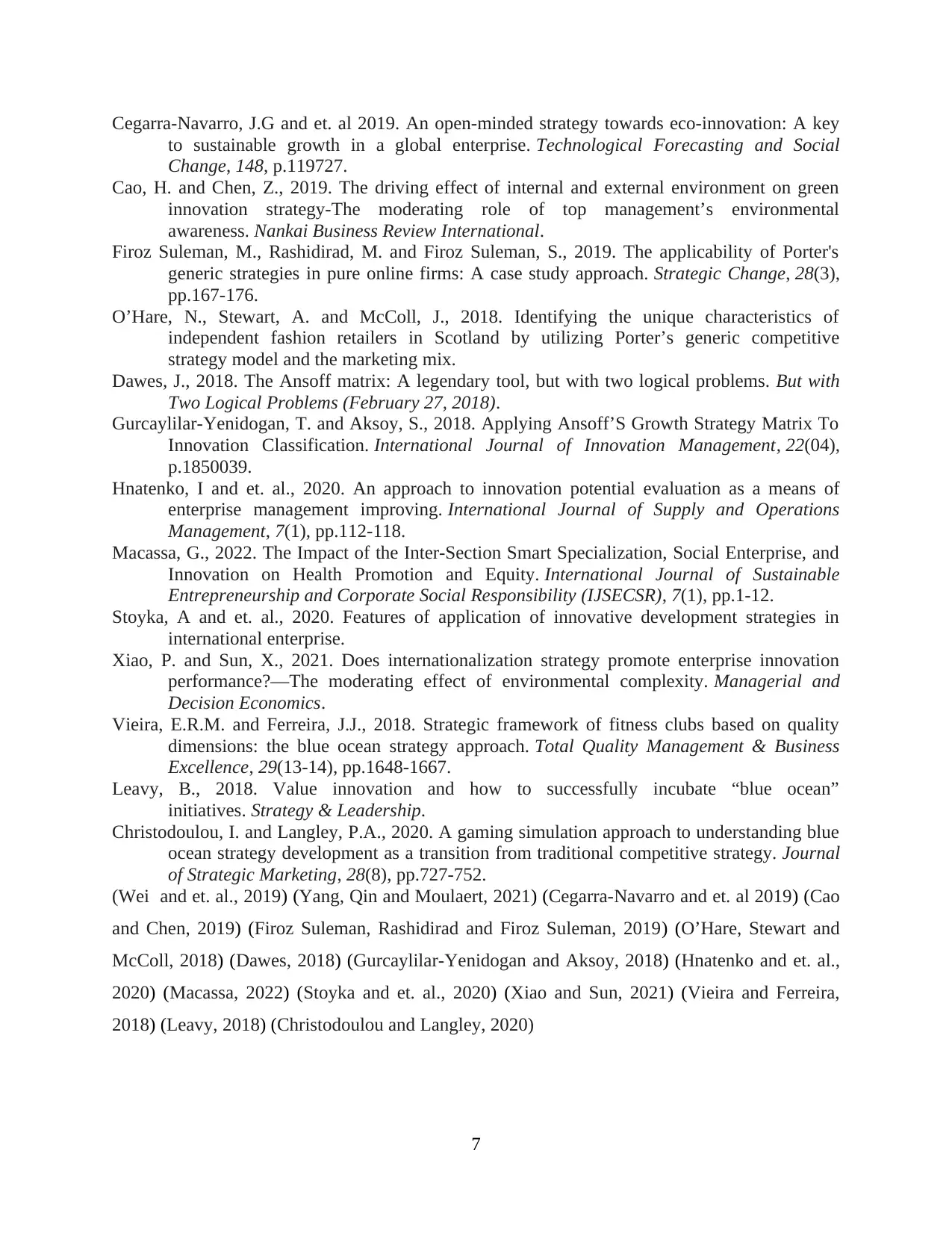
Cegarra-Navarro, J.G and et. al 2019. An open-minded strategy towards eco-innovation: A key
to sustainable growth in a global enterprise. Technological Forecasting and Social
Change, 148, p.119727.
Cao, H. and Chen, Z., 2019. The driving effect of internal and external environment on green
innovation strategy-The moderating role of top management’s environmental
awareness. Nankai Business Review International.
Firoz Suleman, M., Rashidirad, M. and Firoz Suleman, S., 2019. The applicability of Porter's
generic strategies in pure online firms: A case study approach. Strategic Change, 28(3),
pp.167-176.
O’Hare, N., Stewart, A. and McColl, J., 2018. Identifying the unique characteristics of
independent fashion retailers in Scotland by utilizing Porter’s generic competitive
strategy model and the marketing mix.
Dawes, J., 2018. The Ansoff matrix: A legendary tool, but with two logical problems. But with
Two Logical Problems (February 27, 2018).
Gurcaylilar-Yenidogan, T. and Aksoy, S., 2018. Applying Ansoff’S Growth Strategy Matrix To
Innovation Classification. International Journal of Innovation Management, 22(04),
p.1850039.
Hnatenko, I and et. al., 2020. An approach to innovation potential evaluation as a means of
enterprise management improving. International Journal of Supply and Operations
Management, 7(1), pp.112-118.
Macassa, G., 2022. The Impact of the Inter-Section Smart Specialization, Social Enterprise, and
Innovation on Health Promotion and Equity. International Journal of Sustainable
Entrepreneurship and Corporate Social Responsibility (IJSECSR), 7(1), pp.1-12.
Stoyka, A and et. al., 2020. Features of application of innovative development strategies in
international enterprise.
Xiao, P. and Sun, X., 2021. Does internationalization strategy promote enterprise innovation
performance?—The moderating effect of environmental complexity. Managerial and
Decision Economics.
Vieira, E.R.M. and Ferreira, J.J., 2018. Strategic framework of fitness clubs based on quality
dimensions: the blue ocean strategy approach. Total Quality Management & Business
Excellence, 29(13-14), pp.1648-1667.
Leavy, B., 2018. Value innovation and how to successfully incubate “blue ocean”
initiatives. Strategy & Leadership.
Christodoulou, I. and Langley, P.A., 2020. A gaming simulation approach to understanding blue
ocean strategy development as a transition from traditional competitive strategy. Journal
of Strategic Marketing, 28(8), pp.727-752.
(Wei and et. al., 2019) (Yang, Qin and Moulaert, 2021) (Cegarra-Navarro and et. al 2019) (Cao
and Chen, 2019) (Firoz Suleman, Rashidirad and Firoz Suleman, 2019) (O’Hare, Stewart and
McColl, 2018) (Dawes, 2018) (Gurcaylilar-Yenidogan and Aksoy, 2018) (Hnatenko and et. al.,
2020) (Macassa, 2022) (Stoyka and et. al., 2020) (Xiao and Sun, 2021) (Vieira and Ferreira,
2018) (Leavy, 2018) (Christodoulou and Langley, 2020)
7
to sustainable growth in a global enterprise. Technological Forecasting and Social
Change, 148, p.119727.
Cao, H. and Chen, Z., 2019. The driving effect of internal and external environment on green
innovation strategy-The moderating role of top management’s environmental
awareness. Nankai Business Review International.
Firoz Suleman, M., Rashidirad, M. and Firoz Suleman, S., 2019. The applicability of Porter's
generic strategies in pure online firms: A case study approach. Strategic Change, 28(3),
pp.167-176.
O’Hare, N., Stewart, A. and McColl, J., 2018. Identifying the unique characteristics of
independent fashion retailers in Scotland by utilizing Porter’s generic competitive
strategy model and the marketing mix.
Dawes, J., 2018. The Ansoff matrix: A legendary tool, but with two logical problems. But with
Two Logical Problems (February 27, 2018).
Gurcaylilar-Yenidogan, T. and Aksoy, S., 2018. Applying Ansoff’S Growth Strategy Matrix To
Innovation Classification. International Journal of Innovation Management, 22(04),
p.1850039.
Hnatenko, I and et. al., 2020. An approach to innovation potential evaluation as a means of
enterprise management improving. International Journal of Supply and Operations
Management, 7(1), pp.112-118.
Macassa, G., 2022. The Impact of the Inter-Section Smart Specialization, Social Enterprise, and
Innovation on Health Promotion and Equity. International Journal of Sustainable
Entrepreneurship and Corporate Social Responsibility (IJSECSR), 7(1), pp.1-12.
Stoyka, A and et. al., 2020. Features of application of innovative development strategies in
international enterprise.
Xiao, P. and Sun, X., 2021. Does internationalization strategy promote enterprise innovation
performance?—The moderating effect of environmental complexity. Managerial and
Decision Economics.
Vieira, E.R.M. and Ferreira, J.J., 2018. Strategic framework of fitness clubs based on quality
dimensions: the blue ocean strategy approach. Total Quality Management & Business
Excellence, 29(13-14), pp.1648-1667.
Leavy, B., 2018. Value innovation and how to successfully incubate “blue ocean”
initiatives. Strategy & Leadership.
Christodoulou, I. and Langley, P.A., 2020. A gaming simulation approach to understanding blue
ocean strategy development as a transition from traditional competitive strategy. Journal
of Strategic Marketing, 28(8), pp.727-752.
(Wei and et. al., 2019) (Yang, Qin and Moulaert, 2021) (Cegarra-Navarro and et. al 2019) (Cao
and Chen, 2019) (Firoz Suleman, Rashidirad and Firoz Suleman, 2019) (O’Hare, Stewart and
McColl, 2018) (Dawes, 2018) (Gurcaylilar-Yenidogan and Aksoy, 2018) (Hnatenko and et. al.,
2020) (Macassa, 2022) (Stoyka and et. al., 2020) (Xiao and Sun, 2021) (Vieira and Ferreira,
2018) (Leavy, 2018) (Christodoulou and Langley, 2020)
7
⊘ This is a preview!⊘
Do you want full access?
Subscribe today to unlock all pages.

Trusted by 1+ million students worldwide
1 out of 9
Related Documents
Your All-in-One AI-Powered Toolkit for Academic Success.
+13062052269
info@desklib.com
Available 24*7 on WhatsApp / Email
![[object Object]](/_next/static/media/star-bottom.7253800d.svg)
Unlock your academic potential
Copyright © 2020–2025 A2Z Services. All Rights Reserved. Developed and managed by ZUCOL.





